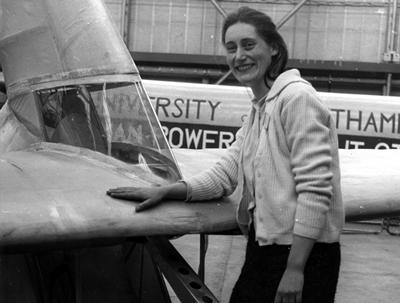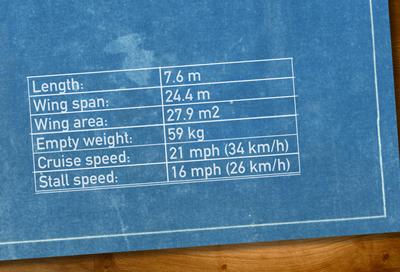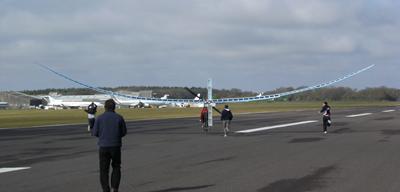In 1961, a group of pioneering aeronautical engineering students made aviation history by designing, building and flying the world’s first human-powered aircraft. Human-powered aircraft are powered solely by the human(s) on board, requiring no mechanical or motorised assistance to become airborne, cruise or land.

A team of postgraduate students, David Williams, Ann Marsden and Alan Lassiere, began designing Southampton University Man Powered Aircraft (SUMPAC) in early 1960. SUMPAC was designed and built to compete for the £50,000 Kremer prize, awarded to pioneers of human-powered flight. The Royal Aeronautical Society competition required that aircraft flew a one-mile course, in a figure of eight.
The single-seat aircraft was built from balsa, plywood and aluminium, and covered in Nylon. The aircraft was powered by a pilot who pedalled cycle pedals that were mounted to the front of the aircraft, giving it forward momentum on the ground, and providing power to the large propeller.

The maiden flight of the pedal-powered aircraft, by expert glider pilot Derek Piggot, took place on 9 November 1961, covering a distance of approximately 64 metres, 1.8 metres above the runway. Whilst the first flight was short, it was a historic moment as any previous human-powered aircraft needed help to take off. However as the aircraft was very difficult to turn, the team were unable to fly in the required figure of eight. The first Kremer prize wasn’t won until 16 years later in 1977.
The aircraft was developed further, including a change from Nylon to a lightweight plastic covering for the fuselage, and completed around 40 longer flights before it was retired after a crash, where the pilot was uninjured, but the fragile SUMPAC was severely damaged. The aircraft is now on display in Southampton at the Solent Sky Museum.


Southampton University Human Powered Aircraft (SUHPA)
In 2011, to commemorate the 50th anniversary of SUMPAC, senior lecturer Dr Alex Forrester and a team of ambitious students recreated the events of 50 years previously, but pushing the boundaries of engineering innovation further than before. The ten-person team of engineering undergraduates designed SUHPA using the latest materials and innovations. The structure was built from carbon fibre reinforced polymer, with a time-trial bike at the centre, rather than the wooden and aluminium materials of their predecessors.
Watch Dr Alex Forrester in our 7x5 wind tunnel and find out more about the project.
The students’ design had potential applications far beyond the competition’s aim for sport. Dr Alex Forrester explains: “Perhaps the application with the largest business potential involved harnessing the power of the sun. By adding an electric motor powered by photovoltaic solar cells to the original aircraft, it could remain airborne indefinitely, opening up a wide range of possibilities.
“The fact that the SUHPA was designed to use an autopilot offered the possibility of an easy conversion to an unmanned air vehicle. The applications could include remote sensing, surveillance, telecommunications, meteorology, disaster management and earth science.”
SUHPA’s maiden flight was back at the airfield where human-powered flight’s history was first made, Lasham Airfield in Hampshire. Derek Piggot, the pilot from the 1961 flight, watched from the airfield as SUHPA became airborne.

The engineering design project also featured in Guy Martin’s ‘Speed’ on Channel 4, as our team of engineers helped Guy as he set out to fly the world’s fastest human-powered aircraft. Taking seven months to design, build and test, Guy’s whole aircraft was designed with speed in mind. It needed to be lighter, more aerodynamic and more powerful and faster than ever before. Guy Martin put the aircraft to the test against some of the UK’s top engineers in the Icarus Cup, aiming to beat the world record.